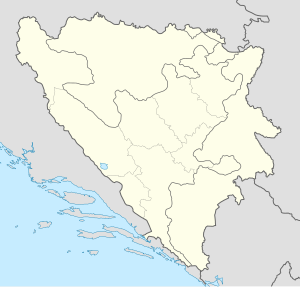
Back Operacija "Vrbas '92" BS Bitka za Jajce 1992. Croatian Vrbas '92 hadművelet Hungarian Врбас-92 Russian Операција Врбас 92 Serbian Операція «Врбас 92» Ukrainian
| Operation Vrbas '92 | |||||||
|---|---|---|---|---|---|---|---|
| Part of the Bosnian War | |||||||
Jajce and nearby towns on the map of Bosnia and Herzegovina | |||||||
| |||||||
| Belligerents | |||||||
|
|
| ||||||
| Commanders and leaders | |||||||
|
|
| ||||||
| Units involved | |||||||
|
| |||||||
| Strength | |||||||
| 7,000–8,000 troops | 3,400–5,500 troops | ||||||
| Casualties and losses | |||||||
| Unknown |
103 killed 492 wounded 5 missing | ||||||
| 30,000–40,000 refugees | |||||||
Operation Vrbas '92 (Serbian: Операција Врбас '92) was a military offensive undertaken by the Army of Republika Srpska (Vojska Republike Srpske – VRS) in June–October 1992, during the Bosnian War. The goal of the operation was the destruction of a salient around the central Bosnian town of Jajce, which was held by the Croatian Defence Council (Hrvatsko vijeće obrane – HVO) and the Army of the Republic of Bosnia and Herzegovina (Armija Republike Bosne i Hercegovine – ARBiH). The intensity of fighting varied considerably and involved several major VRS offensive efforts interspersed by relative lulls in fighting. Jajce fell to the VRS on 29 October 1992, and the town's capture was followed by the destruction of all its mosques and Roman Catholic churches.
The fighting improved the safety of VRS lines of communication south of the Bosnian Serb capital of Banja Luka, and displaced between 30,000 and 40,000 people, in what foreign observers called "the largest and most wretched single exodus" of the Bosnian War. The ARBiH and HVO in Jajce were not only outnumbered and outgunned, but their units were also plagued by inadequate staff work, compounded by lack of coordination between separate command and control structures maintained by the two forces throughout the battle. The defence of Jajce also suffered from worsening Croat–Bosniak relations and skirmishes between the ARBiH and the HVO along the resupply route to Jajce. Ultimately, the outcome of the battle itself fueled greater Bosniak–Croat animosities, which eventually led to the Croat–Bosniak War. The VRS saw the cracking of the ARBiH–HVO alliance as a very significant outcome of the operation.
© MMXXIII Rich X Search. We shall prevail. All rights reserved. Rich X Search
